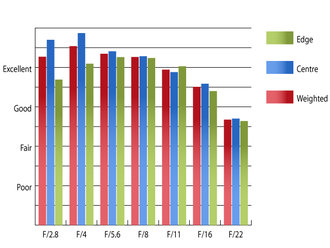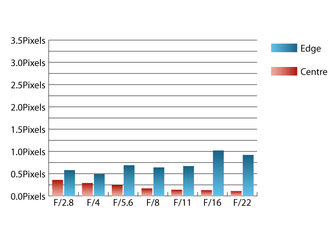Olympus M.Zuiko Digital ED 60mm f/2.8 Macro Lens Review
Olympus M.Zuiko Digital ED 60mm f/2.8 Macro Performance
This little macro lens impresses with outstanding sharpness in the centre of the frame at maximum aperture, with clarity towards the edges of the frame being very good. Stopping down the aperture results in improved sharpness in the centre until f/4, and improved sharpness towards the edges of the frame until f/5.6. Diffraction starts to limit sharpness at smaller apertures, but clarity is still excellent across the frame down to f/8.  Resolution at 60mm | How to read our chartsThe blue column represents readings from the centre of the picture frame at the various apertures and the green is from the edges. Averaging them out gives the red weighted column.The scale on the left side is an indication of actual image resolution. The taller the column, the better the lens performance. Simple. For this review, the lens was tested on a Panasonic Lumix G3 using Imatest. |
Levels of chromatic aberrations are reasonably well-controlled, just exceeding half a pixel width towards the edges of the frame for most apertures. Stopping down beyond f/16 results in a marked increase in fringing towards the edges of the frame, so care may need to be taken photographing high contrast subjects using very small apertures.
 Chromatic aberration at 60mm | How to read our chartsChromatic aberration is the lens' inability to focus on the sensor or film all colours of visible light at the same point. Severe chromatic aberration gives a noticeable fringing or a halo effect around sharp edges within the picture. It can be cured in software.Apochromatic lenses have special lens elements aspheric, extra-low dispersion etc. to minimize the problem, hence they usually cost more. For this review, the lens was tested on a Panasonic Lumix G3 using Imatest. |
Falloff of illumination towards the corners of the frame is well controlled for a lens of this type. At f/2.8 the corners of the frame are 1.02 stops darker than the image centre and illumination is visually uniform with the lens stopped down to f/4 or beyond.
Imatest was only able to detect 0.253% barrel distortion during testing, which is an incredibly low level indeed. This level of distortion is so low that lines parallel to the edges of the image area appear dead straight.
Even when shooting towards the light, this lens is resistant to flare and contrast remains high in all but the most challenging lighting conditions.
Add your message
Login required
Please login here or if you've not registered, you can register here. Registering is safe, quick and free.
Please login here or if you've not registered, you can register here. Registering is safe, quick and free.
photodo Stats
1102 lenses
428 MTF tests
74 in-depth photodo reviews
100+ users join each day
Help the lens community by reviewing or rating a lens today via our lens search
428 MTF tests
74 in-depth photodo reviews
100+ users join each day
Help the lens community by reviewing or rating a lens today via our lens search
Latest Lens Reviews
- Chinon 28mm f/2.8 Vintage Lens Review
- Canon EF 70-200mm f/4L IS II USM Lens Review
- Samyang AF 85mm f/1.4 EF Review
- Sigma 70mm f/2.8 DG Macro Art Review
- Samyang AF 24mm f/2.8 FE Review
- Meike 50mm f/1.7 Review
- Tamron 70-210mm f/4 Di VC USD Review
- Lensbaby Burnside 35mm f/2.8 Review
- Asahi Super Takumar 50mm f/1.4 Review
- Asahi Super-Multi-Coated Takumar 135mm f/3.5 Review
